
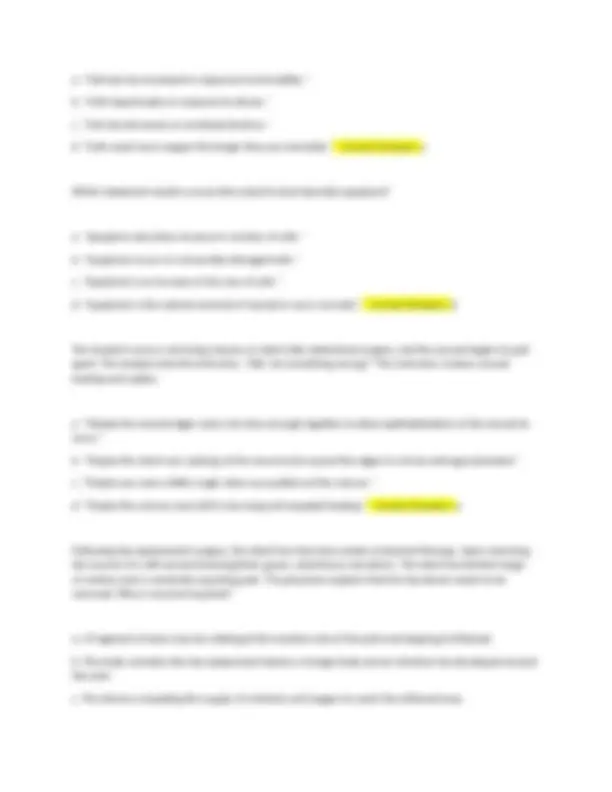
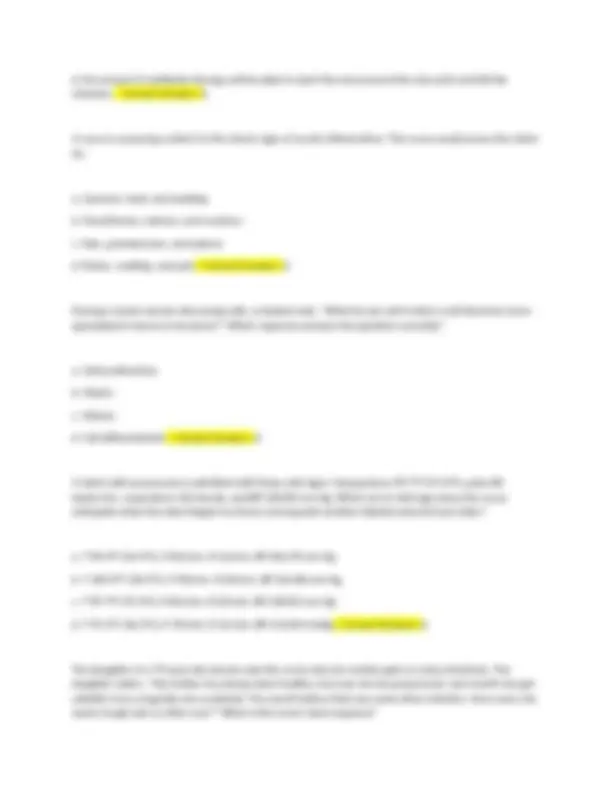
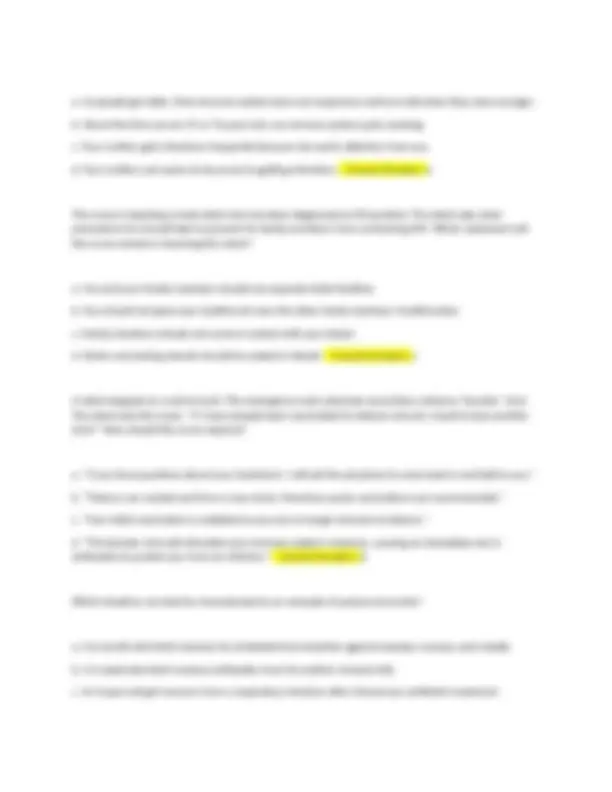
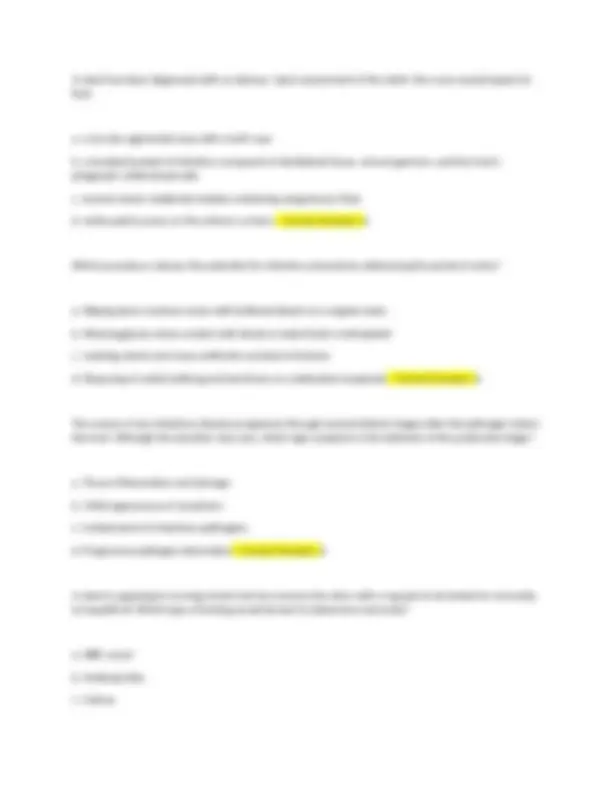
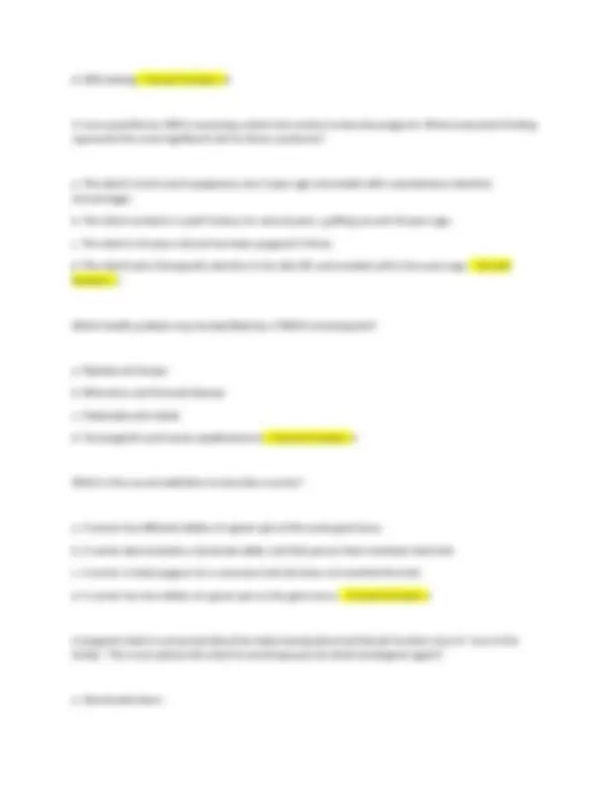
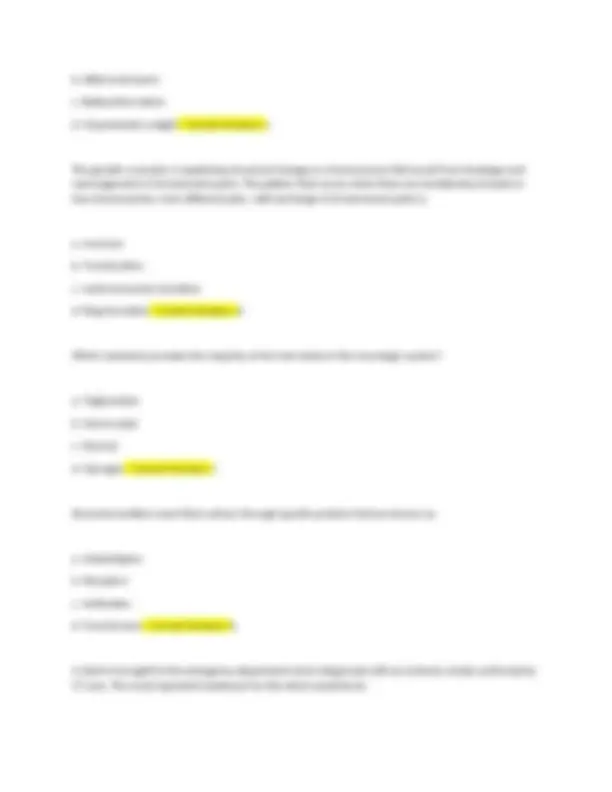
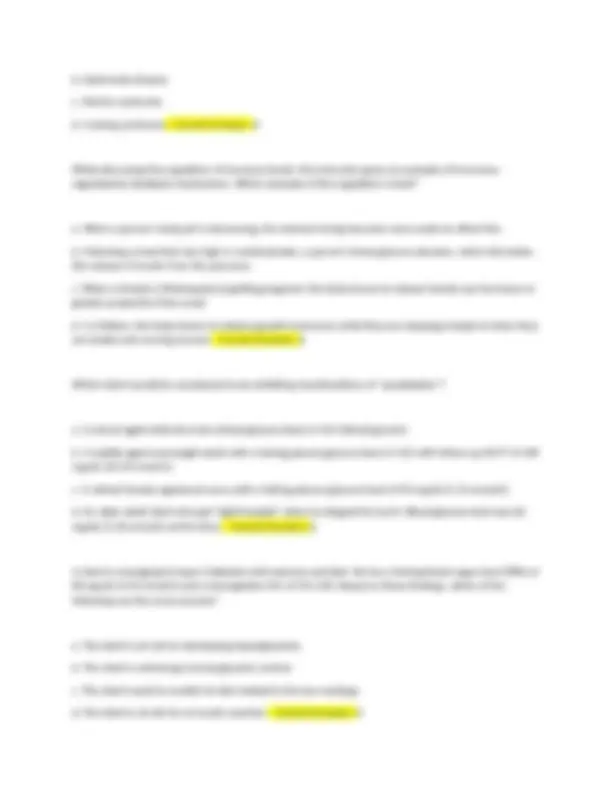
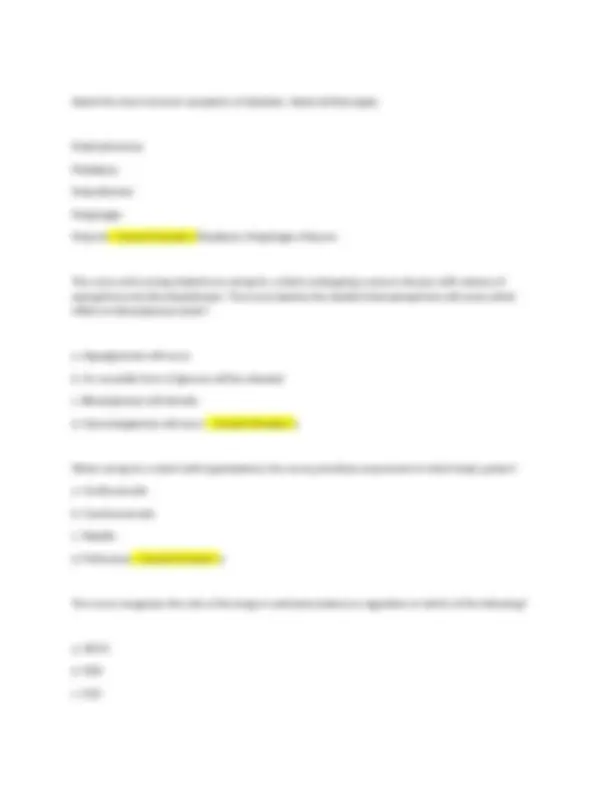
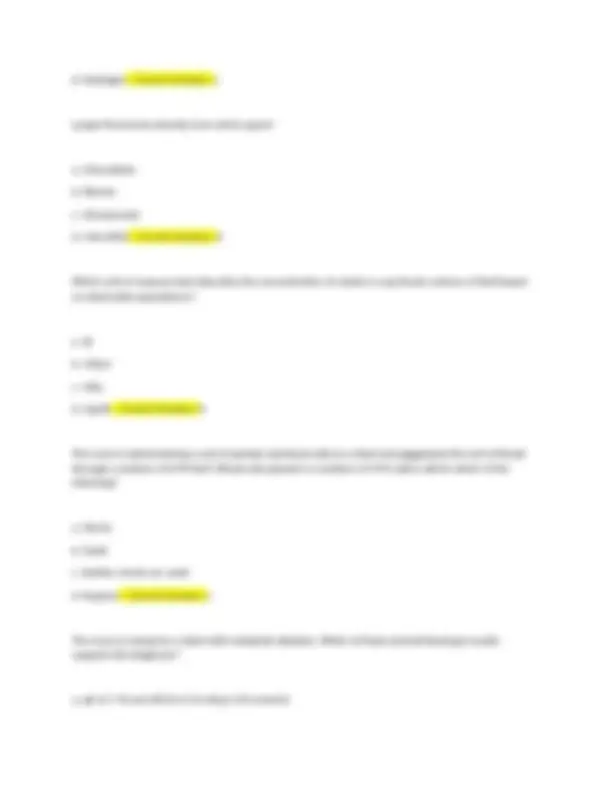
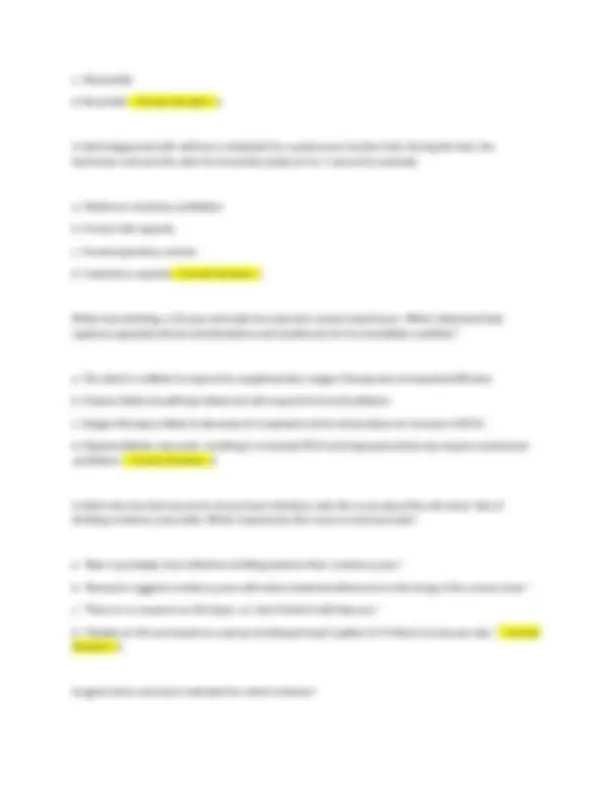
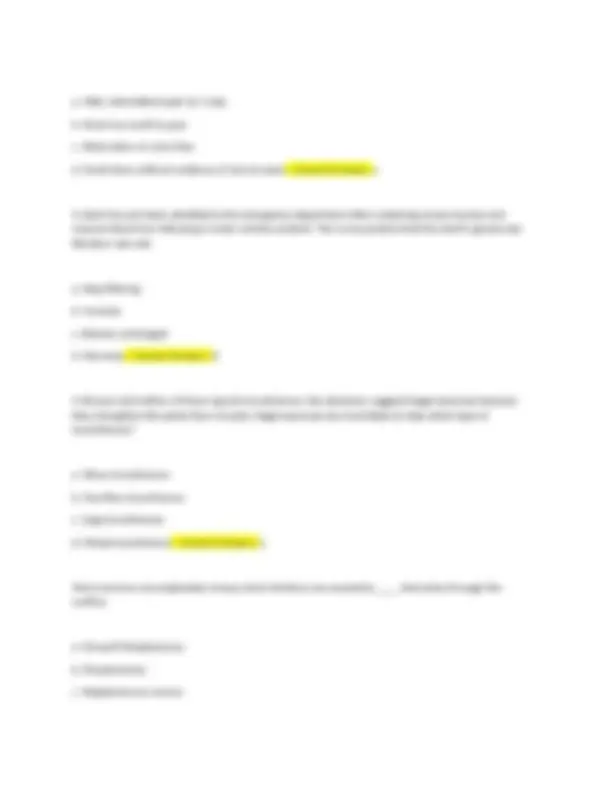
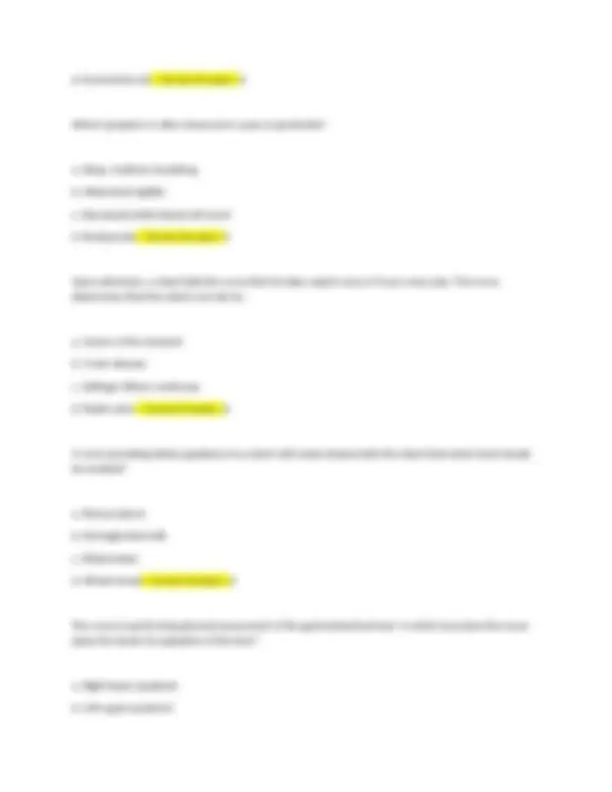
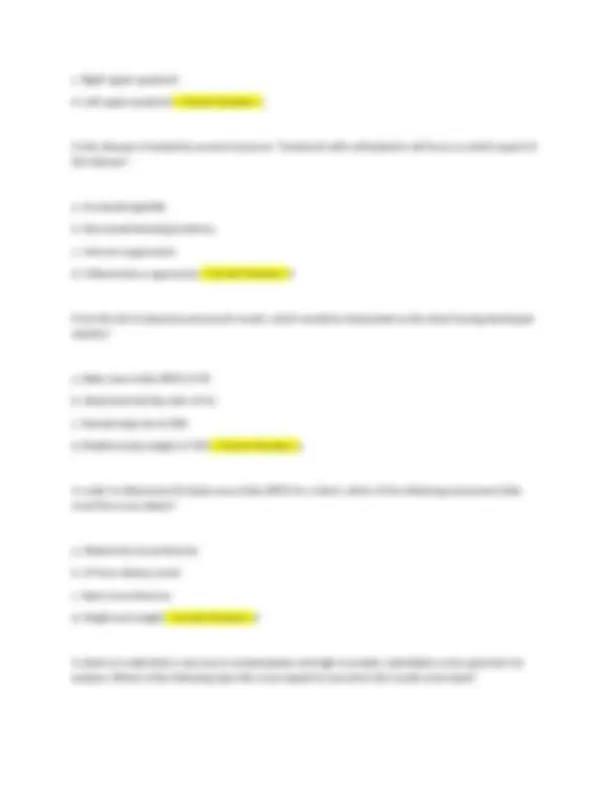
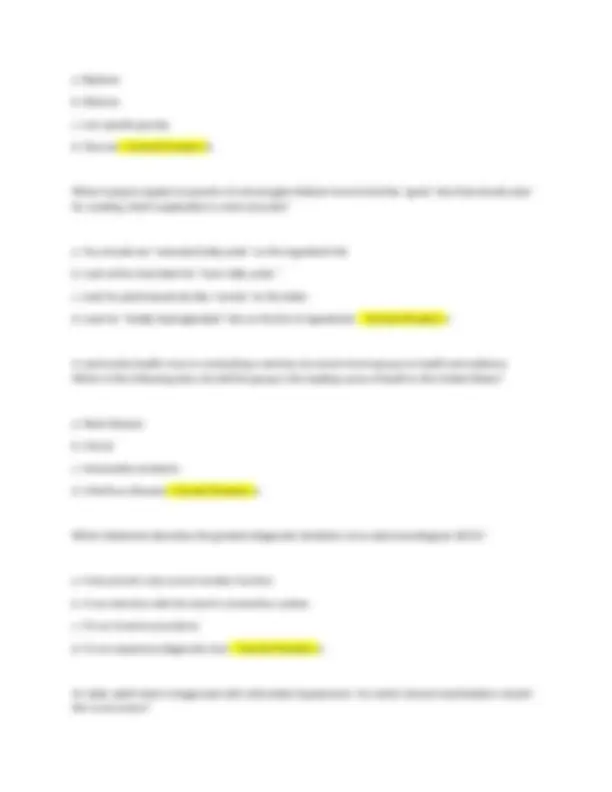
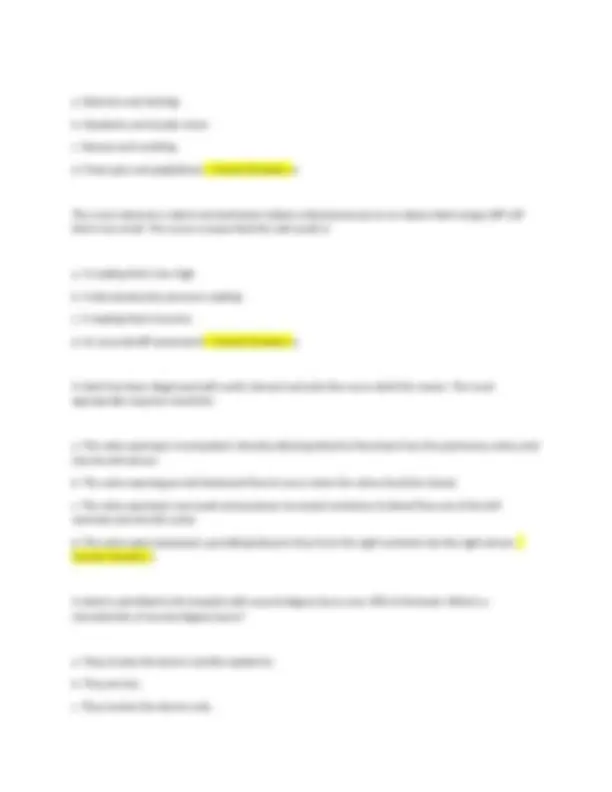
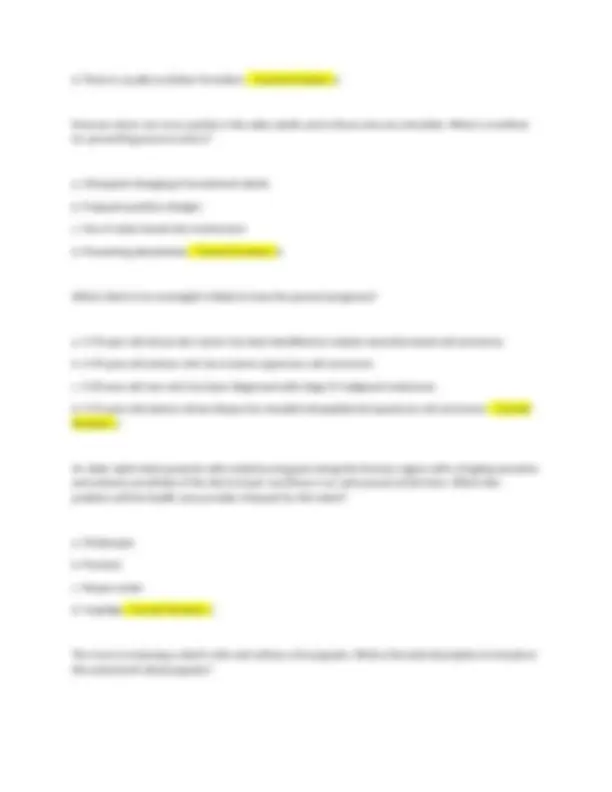
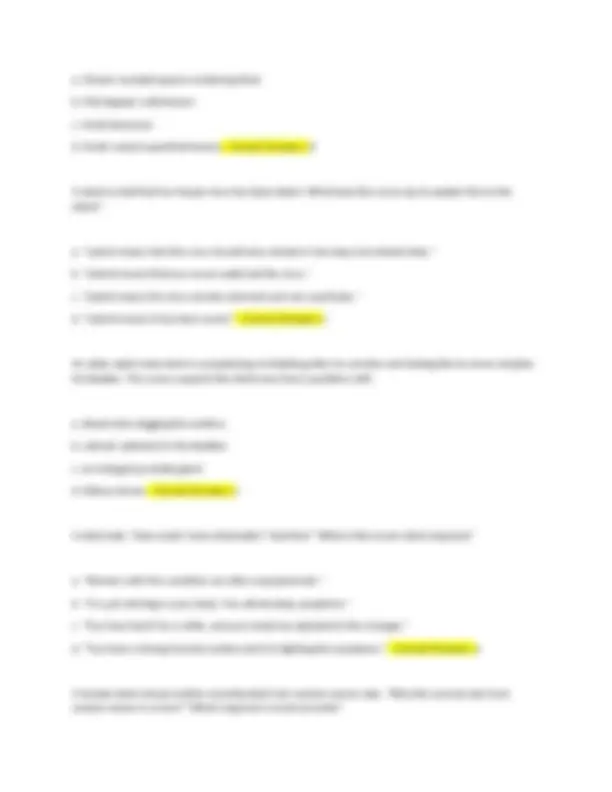
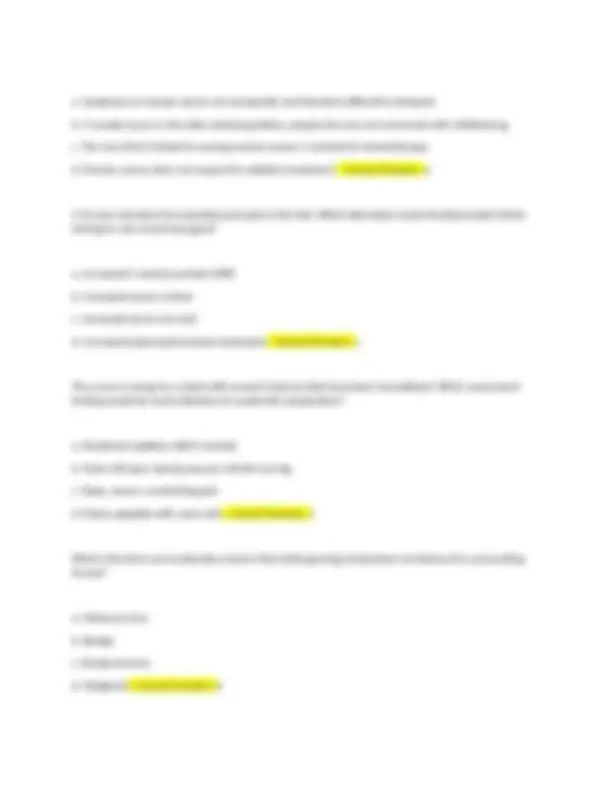
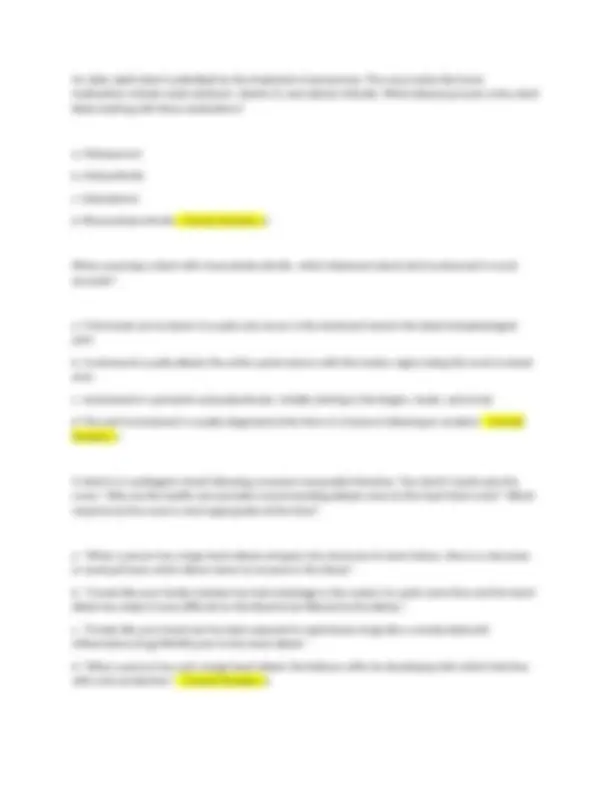
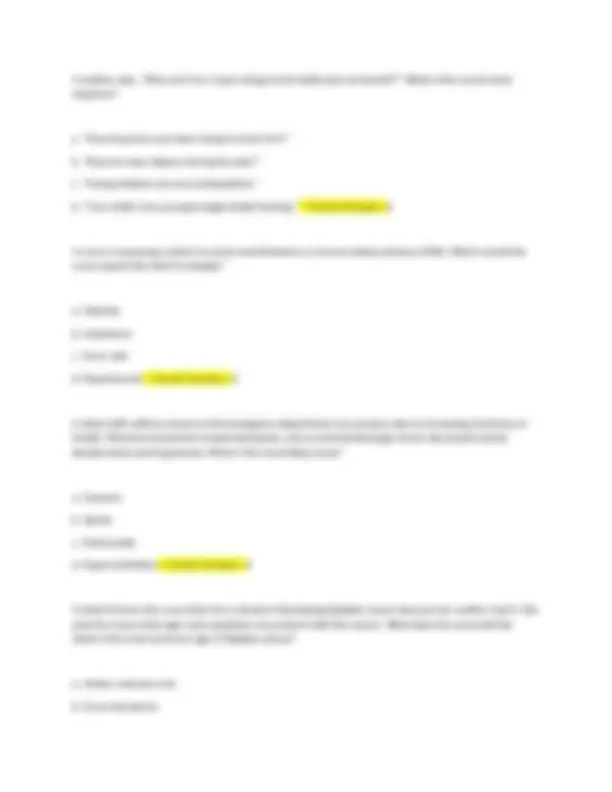
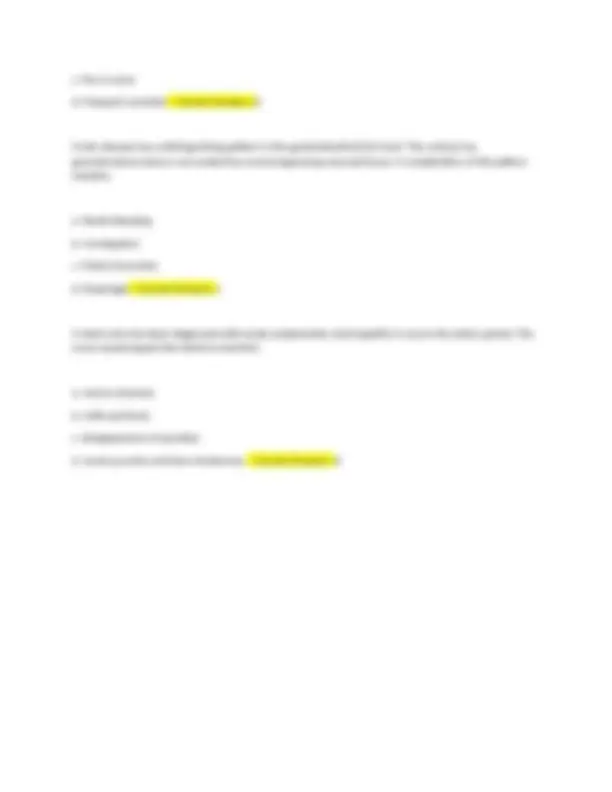


Study with the several resources on Docsity

Earn points by helping other students or get them with a premium plan


Prepare for your exams
Study with the several resources on Docsity

Earn points to download
Earn points by helping other students or get them with a premium plan
Community
Ask the community for help and clear up your study doubts
Discover the best universities in your country according to Docsity users
Free resources
Download our free guides on studying techniques, anxiety management strategies, and thesis advice from Docsity tutors
A series of multiple-choice questions and answers related to pathophysiology, covering topics such as cell function, inflammation, immunity, and cancer. It is a valuable resource for students preparing for a final exam in pathophysiology, offering a comprehensive review of key concepts and principles.
Typology: Exams
1 / 29

This page cannot be seen from the preview
Don't miss anything!






















[COMPANY NAME] [Company address]
A client receives a phone call from her gynecologist's office nurse and is informed that her Pap test results identified mild dysplasia. The best explanation for the nurse to provide would be: a. "Minor degrees of dysplasia are associated with chronic irritation or inflammation. However, we will need to do additional diagnostic studies to confirm the diagnosis." b. "You definitely have cancer." c. "Do not be concerned; this is not abnormal." d. "You need emergency treatment; please come in to the office today." - Correct Answers: a The nurse is educating about the importance of improving the metabolic process in a client who has morbid obesity and is beginning a weight loss program with exercise. What should the nurse inform the client about the importance of improving the metabolic rate? a. Increasing metabolism improves the process by which cells engulf materials from their surroundings to improve electrolyte function. b. Increasing metabolism will allow the client to be able to eat whatever foods he wants as long as he is exercising. c. Increasing metabolism improves the secretion of intracellular substances into the extracellular spaces. d. Increasing metabolism will improve the breakdown of carbohydrates, fats, and proteins to provide energy for cell function. - Correct Answers: d A client has been exercising his arms repeatedly. Which statement by the nurse explains the increase in the size of the arms? a. "Your cells have atrophied in response to increased oxygen." b. "Your cells have hypertrophied in response to increased workload." c. "You have increased your number of cells due to increased oxygenation." d. "You have caused the cells to clump together in response to exercise." - Correct Answers: b What can the nurse tell family members to best explain muscle atrophy of a family member who has been in a persistent coma?
d. No amount of antibiotic therapy will be able to reach the area around the new joint and kill the infection. - Correct Answers: b A nurse is assessing a client for the classic signs of acute inflammation. The nurse would assess the client for: a. Cyanosis, heat, and swelling b. Paresthesias, redness, and coolness c. Pain, pulselessness, and edema d. Rubor, swelling, and pain - Correct Answers: d During a review session discussing cells, a student asks, "What do you call it when a cell becomes more specialized in terms of structure?" Which response answers the question correctly? a. Cell proliferation b. Matrix c. Mitosis d. Cell differentiation - Correct Answers: d A client with pneumonia is admitted with these vital signs: temperature 99.7ºF (37.6°F), pulse 80 beats/min, respirations 18/minute, and BP 120/80 mm Hg. Which set of vital signs does the nurse anticipate when the client begins to shiver and requests another blanket several hours later? a. T 98.4ºF (36.9°C), P 82/min, R 16/min, BP 106/70 mm Hg b. T 100.9ºF (38.3°C), P 90/min, R 20/min, BP 126/80 mm Hg c. T 99.7ºF (37.6°C), P 86/min, R 18/min, BP 130/82 mm Hg d. T 97.2ºF (36.2°C), P 70/min, R 12/min, BP 114/60 mmHg - Correct Answers: b The daughter of a 79-year-old woman asks the nurse why her mother gets so many infections. The daughter states, "My mother has always been healthy, but now she has pneumonia. Last month she got cellulitis from a bug bite she scratched. The month before that was some other infection. How come she seems to get sick so often now?" What is the nurse's best response?
a. As people get older, their immune system does not respond as well as it did when they were younger. b. About the time we are 75 or 76 years old, our immune system quits working. c. Your mother gets infections frequently because she wants attention from you. d. Your mother just seems to be prone to getting infections. - Correct Answers: a The nurse is teaching a male client who has been diagnosed as HIV positive. The client asks what precautions he should take to prevent his family members from contracting HIV. Which statement will the nurse include in teaching this client? a. You and your family members should use separate toilet facilities. b. You should not place your toothbrush near the other family members' toothbrushes. c. Family members should not come in contact with your blood. d. Dishes and eating utensils should be soaked in bleach. - Correct Answers: c A client stepped on a nail at work. The emergency room physician prescribes a tetanus "booster" shot. The client asks the nurse, "If I have already been vaccinated for tetanus why do I need to have another shot?" How should the nurse respond? a. "If you have questions about your treatment, I will ask the physician to come back in and talk to you." b. "Tetanus can mutate and form a new strain; therefore yearly vaccinations are recommended." c. "Your initial vaccination is outdated so you are no longer immune to tetanus." d. "The booster shot will stimulate your immune system's memory, causing an immediate rise in antibodies to protect you from an infection." - Correct Answers: d Which situation can best be characterized as an example of passive immunity? a. A 6-month-old infant receives his scheduled immunization against measles, mumps, and rubella. b. A 6-week-old infant receives antibodies from his mother's breast milk. c. An 8-year-old girl recovers from a respiratory infection after intravenous antibiotic treatment.
b. "Cancer always spreads through the lymph nodes." c. "Cancer can only spread through the blood vessels." d. "Cancer spreads through the lymph channels and the blood vessels." - Correct Answers: d A client has a hematocrit of 32% and is diagnosed with iron deficiency anemia. The nurse anticipates which treatment to be prescribed? a. Iron replacement therapy b. Splenectomy c. Continued monitoring with weekly laboratory tests d. Bone marrow transplant - Correct Answers: a Following a biopsy, a 54-year-old man has been diagnosed as having a benign neoplastic tumor. Which characteristic most likely applies to his tumor? a. The well-differentiated, neoplastic cells are clustered together in a single mass. b. It has a rapid rate of growth and can induce ischemia. c. The tumor is poorly approximated and has the potential to break loose. d. The tumor may secrete hormones, cytokines. - Correct Answers: a A nurse is teaching a group of clients about health promotion activities and lifestyle changes. A client tells the nurse he has smoked two packs of cigarettes a day for the last 4 years and has been told he is at risk for developing respiratory infections. The best response would be: a. "You can decrease your risk by only smoking one pack per day." b. "Smoking will not increase the risk of inhalation-acquired diseases." c. "Smoking can increase the risk of inhalation-acquired diseases." d. "Smoking will destroy any inhalation-acquired diseases." - Correct Answers: c
A client has been diagnosed with an abscess. Upon assessment of the client, the nurse would expect to find: a. a circular pigmented area with a bull's-eye b. a localized pocket of infection composed of devitalized tissue, microorganisms, and the host's phagocytic white blood cells. c. several raised, reddened nodules containing sanguineous fluid. d. white patchy areas on the anterior surface. - Correct Answers: b Which procedure reduces the potential for infection primarily by addressing the portal of entry? a. Wiping down common areas with buffered bleach on a regular basis b. Wearing gloves when contact with blood or body fluids is anticipated c. Isolating clients who have antibiotic-resistant infections d. Disposing of soiled clothing and bed linens in a dedicated receptacle - Correct Answers: b The course of any infectious disease progresses through several distinct stages after the pathogen enters the host. Although the duration may vary, which sign/symptom is the hallmark of the prodromal stage? a. Tissue inflammation and damage b. Initial appearance of symptoms c. Containment of infectious pathogens d. Progressive pathogen elimination - Correct Answers: b A client is applying to nursing school and has come to the clinic with a request to be tested for immunity to hepatitis B. Which type of testing would be best to determine immunity? a. WBC count b. Antibody titer c. Culture
b. Wild mushrooms c. Radioactive iodine d. Unprotected sunlight - Correct Answers: c The genetic counselor is explaining structural changes in chromosomes that result from breakage and rearrangement of chromosome parts. The pattern that occurs when there are simultaneous breaks in two chromosomes, from different pairs, with exchange of chromosome parts is: a. Inversion b. Translocation c. Isochromosome formation d. Ring formation - Correct Answers: b Which substance provides the majority of the fuel needs of the neurologic system? a. Triglycerides b. Amino acids c. Glucose d. Glycogen - Correct Answers: c Neurotransmitters exert their actions through specific proteins that are known as: a. Autoantigens b. Receptors c. Antibodies d. Transformers - Correct Answers: b A client is brought to the emergency department and is diagnosed with an ischemic stroke confirmed by CT scan. The most important treatment for this client would be to:
a. administer analgesics for the relief of pain. b. prepare the client for emergency surgery. c. monitor vital signs closely for improvement. d. administer IV tissue plasminogen activator (tPA). - Correct Answers: d The underlying causative problem in Parkinsonism is: a. Autoimmune disorder b. Failure of dopamine release c. Viral infection d. Genetic defect - Correct Answers: b During physiology class, the instructor asks students to explain the pathology behind development of multiple sclerosis. Which student gave the most accurate description? a. The demyelination and subsequent degeneration of nerve fibers and decreased oligodendrocytes, which interfere with nerve conduction b. Atherosclerotic destruction of circulation to the brain, resulting in lactic acid buildup that affects nerve transmission c. Muscle necrosis with resultant increase in fat/connective tissue replacing the muscle fibers d. Autoimmune disease where antibody loss of acetylcholine receptors at the neuromuscular junction causes decreased motor response - Correct Answers: a Death caused by muscular dystrophy in early adulthood is usually due to: a. severe skeletal muscle weakness. b. severe long bone fractures. c. respiratory and cardiac muscle involvement. d. malnutrition. - Correct Answers: c
b. Hashimoto disease c. Marfan syndrome d. Cushing syndrome - Correct Answers: d While discussing the regulation of hormone levels, the instructor gives an example of hormones regulated by feedback mechanisms. Which example of this regulation is best? a. When a person's body pH is decreasing, the stomach lining becomes more acidic to offset this. b. Following a meal that was high in carbohydrates, a person's blood glucose elevates, which stimulates the release of insulin from the pancreas. c. When a female is thinking about getting pregnant, the body knows to release female sex hormones in greater proportion than usual. d. In children, the body knows to release growth hormones while they are sleeping instead of when they are awake and running around. - Correct Answers: b Which client would be considered to be exhibiting manifestations of "prediabetes"? a. A school-aged child who had a blood glucose level of 115 following lunch. b. A middle-aged overweight adult with a fasting plasma glucose level of 122 with follow-up OGTT of 189 mg/dL (10.49 mmol/L). c. A retired female registered nurse with a fasting plasma glucose level of 92 mg/dL (5.11 mmol/L). d. An older adult client who got "light-headed" when he skipped his lunch. Blood glucose level was 60 mg/dL (3.33 mmol/L) at this time. - Correct Answers: b A client is managing his type 2 diabetes with exercise and diet. He has a fasting blood sugar level (FBS) of 80 mg/dL (4.44 mmol/L) and a hemoglobin A1C of 5% (.05). Based on these findings, which of the following can the nurse assume? a. The client is at risk for developing hyperglycemia. b. The client is achieving normal glycemic control. c. The client needs to modify his diet related to the low readings. d. The client is at risk for an insulin reaction. - Correct Answers: b
Select the most common symptoms of diabetes. Select all that apply. Polyhydramnios Polydipsia Polycythemia Polyphagia Polyuria - Correct Answers: Polydipsia, Polyphagia, Polyuria The nurse and nursing student are caring for a client undergoing a severe stressor with release of epinephrine into the bloodstream. The nurse teaches the student that epinephrine will cause which effect on blood glucose levels? a. Hypoglycemia will occur. b. An unusable form of glucose will be released. c. Blood glucose will elevate. d. Gluconeogenesis will occur. - Correct Answers: c When caring for a client with hyperkalemia, the nurse prioritizes assessment of which body system? a. Cardiovascular b. Cerebrovascular c. Hepatic d. Pulmonary - Correct Answers: a The nurse recognizes the role of the lungs in acid-base balance is regulation of which of the following? a. HCO b. H2O c. CO
b. pH of 7.50 and HCO3 of 45 mEq/L (45 mmol/L) c. pH of 7.25 and HCO3 of 18 mEq/L (18 mmol/L) d. pH of 7.35 and HCO3 of 22 mEq/L (22 mmol/L) - Correct Answers: b The renal control mechanism of restoring the acid-base balance is accomplished through which process? a. Regulation of the production of carbonic acid b. Reabsorption of hydrogen and excretion of carbonic acid c. Stimulation of the chemoreceptors in the brain stem d. Reabsorption of HCO3 and excretion of H+ restores acid-base balance through the renal control mechanisms. - Correct Answers: d The condition of a client with metabolic acidosis from an intestinal fistula is not improving. The pulse is 125 beats/min and the BP 84/56 mm Hg. ABG values are: pH 7.1, HCO3- 18 mEq/L (18 mmol/L), PCO2 57 mm Hg (7.58 kPa). What IV medication should the nurse expect to provide next? a. Sodium bicarbonate b. Epinephrine c. Potassium chloride d. Antibiotics - Correct Answers: a The nurse is caring for a client with a tumor obstructing the lymphatic system. For which consequence does the nurse assess? a. Fluid accumulating in the interstitial spaces distal to the tumor b. Plasma protein accumulating in the circulatory system c. Fluid being trapped in intercellular spaces d. The client developing circulatory overload - Correct Answers: a
An older adult client recently had a cerebrovascular accident that resulted in dysphagia. What is the nurse's greatest concern while feeding this client? a. Failure to thrive b. Aspiration c. Accidental biting of cheek d. Pocketing of food in cheeks - Correct Answers: b Which client is at risk for developing a preventable disorder related to prolonged immobility? a. A middle-aged adult male diagnosed with bronchitis related to chronic smoking b. A client with sleep apnea related to a history of smoking who utilizes a CPAP machine every night at bedtime to maintain airway c. A young adult female diagnosed with sarcoidosis requiring corticosteroids to return her to remission d. A postsurgical client who is refusing to get out of bed and walk and will not wear those "uncomfortable elastic stockings" - Correct Answers: d A client is diagnosed with a stroke that affects the left hemisphere of the brain, and the health care provider has prescribed testing to assess for damage to the glottis. Which action should the nurse take prior to allowing the client to receive food/beverages from the cafeteria? a. Identify whether the client can make reasonable decisions versus poor reasoning skills b. Assess ability to swallow and check breath sounds for signs aspiration pneumonia c. Monitor for impaired memory and judgment d. Assess for attention deficits which will determine whether the client can feed oneself without assistance - Correct Answers: b Unilateral chest pain associated with respiratory movements is usually described as which of the following? a. Pleuritic b. Musculoskeletal
a. Mild, intermittent pain for 1 day b. Stone too small to pass c. Obstruction of urine flow d. Small stone without evidence of size increase - Correct Answers: c A client has just been admitted to the emergency department after sustaining severe injuries and massive blood loss following a motor vehicle accident. The nurse predicts that the client's glomerular filtration rate will: a. Stop filtering b. Increase c. Remain unchanged d. Decrease - Correct Answers: d A 40-year-old mother of three reports incontinence. Her physician suggests Kegel exercises because they strengthen the pelvic floor muscles. Kegel exercises are most likely to help which type of incontinence? a. Stress incontinence b. Overflow incontinence c. Urge incontinence d. Mixed incontinence - Correct Answers: a Most common uncomplicated urinary tract infections are caused by ____ that enter through the urethra. a. Group B Streptococcus b. Pseudomonas c. Staphylococcus aureus
d. Escherichia coli - Correct Answers: d Which symptom is often observed in cases of peritonitis? a. Deep, rhythmic breathing b. Abdominal rigidity c. Decreased white blood cell count d. Bradycardia - Correct Answers: b Upon admission, a client tells the nurse that he takes aspirin every 4 hours every day. The nurse determines that this client is at risk for: a. Cancer of the stomach b. Crohn disease c. Zollinger-Ellison syndrome d. Peptic ulcer - Correct Answers: d A nurse providing dietary guidance to a client with celiac disease tells the client that which food should be avoided? a. Pork products b. Homogenized milk c. Watermelon d. Wheat bread - Correct Answers: d The nurse is performing physical assessment of the gastrointestinal tract. In which area does the nurse place the hands for palpation of the liver? a. Right lower quadrant b. Left upper quadrant